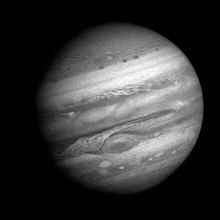Diferenciální rotace
Diferenciální rotace je pozorována, když se různé části rotujícího tělesa pohybují různou úhlovou rychlostí. To znamená, že těleso není tuhé. V tekutých objektech, jako třeba akrečním disku,[1] to vede ke smyku. Galaxie a protohvězdy většinou vykazují diferenciální rotaci; a příklady v naší sluneční soustavě jsou např. Slunce, Jupiter a Saturn.
Odkazy
Reference
V tomto článku byl použit překlad textu z článku Differential rotation na anglické Wikipedii.
Související články
Média použitá na této stránce
Jupiter seen by Voyager 1 probe with blue filter. One image was taken every Jupiter day (approximately 10 hours). These pictures were taken from 01/06 to 02/03, 1979 ; and Voyager 1 flew from 58 million to 31 million kilometers from Jupiter during that time. The small, round, dark spots appearing in some frames are the shadows cast by the moons passing between Jupiter and the Sun, while the small, white flashes around the planet, are the moons themselves.
This Theora OGG movie was downscaled to half size and then transcoded at the maximum possible quality from the original NASA GIF animation at http://photojournal.jpl.nasa.gov/browse/PIA02855.gif linked from http://photojournal.jpl.nasa.gov/animation/PIA02855, see Source below for details.
Suggested for English Wikipedia:alternative text for images: animated view of planet getting larger. These pictures were taken every 10 hours over 28 days in 1979; each frame shows Jupiter at the same local time with the Great Red Spot appearing stationary within its cloud belt while clouds move right to left past it; other cloud belts move left to right. The small, round, dark spots appearing in some frames are the shadows cast by the moons passing between Jupiter and the Sun, while the small, white flashes around the planet, are the moons themselves.
